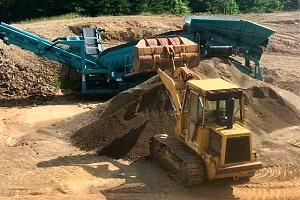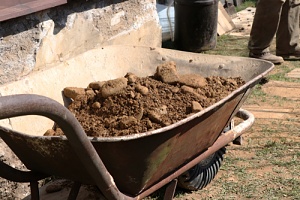 Water damage to your home, especially the foundation, can be devastating. If you have discovered water that leaks into your foundation, you know it can lead to severe and costly damages. You also need to figure out how to prevent the water from reaching the foundation again in the future.
Water damage to your home, especially the foundation, can be devastating. If you have discovered water that leaks into your foundation, you know it can lead to severe and costly damages. You also need to figure out how to prevent the water from reaching the foundation again in the future.
The water either wears down the structure over time by simply sitting there or it causes moisture problems in your basement as it leaks in through the cracks and holes that already exist in your foundation. Because of this, it is extremely important to ensure no water is leaking in your home or on the side of your home. However, your foundation may be significantly exposed, allowing rain water to easily find its way to the top or side of the foundation.
Building Up Dirt Around Your Home’s Foundation
The best way to combat this issue and improve drainage is to grade the soil around your home using dirt. This will allow the water to flow away from your home instead of into it. Follow the step-by-step guide below if you want to know how to build up dirt around foundation. The process is pretty straightforward and can provide you with a fix to that water leaking into your foundation.
Step 1: Get Your Starting Point
To get started, you first need to measure the existing slope of your yard – this will essentially give you your starting point. To effectively obtain this measurement, you will need a 10-foot wood board. Simply set one end of the board on the ground directly next to the foundation of your home.
Then, put a level at an ideal position on top of your board. Lift the remaining end of the 10-foot board until your level shows that the board is positioned evenly. Then, measure the length from where the board ends to the ground. Write down that measurement.
Step 2: Decide the Slope You want
Before you can move forward, you need to decide how much sloping you actually want. In general, the more sloping away from your home that there is, the better your position for reducing overall moisture issues. However, the recommendations related to soil grading typically depend on your location and type of soil.
Step 3: Build up the Soil Grade
 Next, you must build up the soil grade in order to properly drain water. You can start doing this by putting soil directly against your foundation. You want to make sure you achieve a solid base prior to measuring the distance from the base. Then, use the same 10-foot board used in step 1 to take note of the newly achieved difference in the sloping measurement.
Next, you must build up the soil grade in order to properly drain water. You can start doing this by putting soil directly against your foundation. You want to make sure you achieve a solid base prior to measuring the distance from the base. Then, use the same 10-foot board used in step 1 to take note of the newly achieved difference in the sloping measurement.
If it is not what you wanted, add more dirt and then take the measurement again. Continue this process until you achieve your desired soil grade. Make sure the base is totally soiled before moving on to the next step. Once achieved, continue the same process around the entire foundation of the home so that you get the desired height all the way around.
Step 4: Fill the Remaining Area
The next step is to fill in the area that is remaining around the foundation of your home. You want to do this to about 10 feet out from the perimeter of the home. The rule of thumb is to add dirt starting at the lower heights and then continue to move out from the home. This allows you to achieve a steady slope that is more gradual in nature.
Step 5: Perform a Consistency Check
When you feel like you are finished, make sure you check for consistency. You can do this by using your 10-foot board again. Lay it over the ground again and give the slope another measure.
There are a couple key things to keep in mind for this step. First, you want to make sure the board is sloped down flat. That means placing it in a location without any holes beneath it. If you need to, use some of the remaining dirt to fill in any holes. This will allow you to get the most accurate measurements possible.
Second, when you check the slope, make sure you do so all around the home. You can do this in whatever interval you want – however, we recommend 1-foot intervals to ensure ultimate consistency. This might feel like a tedious and time-consuming step, but it will ensure that the slope is consistent at all points around the house. You do not want a slope that differs as you move around the home.
Fill Dirt vs. Topsoil
 When performing the above steps, keep in mind that the type of dirt you use will make a huge difference. You want to make sure you use fill dirt as the base, and topsoil (as the name suggests) on top. Fill dirt is primarily used for filling in holes, which is precisely why it is the right solution for building up a strong foundation. Fill dirt can also be used to create mounds or otherwise change the elevation or grade of any ground area. This is quite different from the properties provided by topsoil. However, you must know how much fill dirt you need from the start of the project as it is easier to lay topsoil than it is fill dirt.
When performing the above steps, keep in mind that the type of dirt you use will make a huge difference. You want to make sure you use fill dirt as the base, and topsoil (as the name suggests) on top. Fill dirt is primarily used for filling in holes, which is precisely why it is the right solution for building up a strong foundation. Fill dirt can also be used to create mounds or otherwise change the elevation or grade of any ground area. This is quite different from the properties provided by topsoil. However, you must know how much fill dirt you need from the start of the project as it is easier to lay topsoil than it is fill dirt.
Topsoil, in contrast, can and should be used as the top layer (roughly 5 to 10 inches above your fill dirt) when you build up the area around your foundation. Topsoil has minerals and organic matter in its composition, making it the ideal soil to use when trying to create a garden or to plant flowers. And while it is not particularly useful in filling in holes or leveling out the ground, it is often considered more attractive.
Getting Dirt for Your Project
When you build up the area around your foundation, you will likely need to acquire a good amount of fill dirt. With that said, you need to know where to get it. A great option is Dirt Connections. One of the best benefits of using Dirt Connections for your fill dirt needs is that you can be provided with a free fill dirt delivery in Northern Virginia. Reach out to them today for more information on using fill dirt for your foundation project.








































